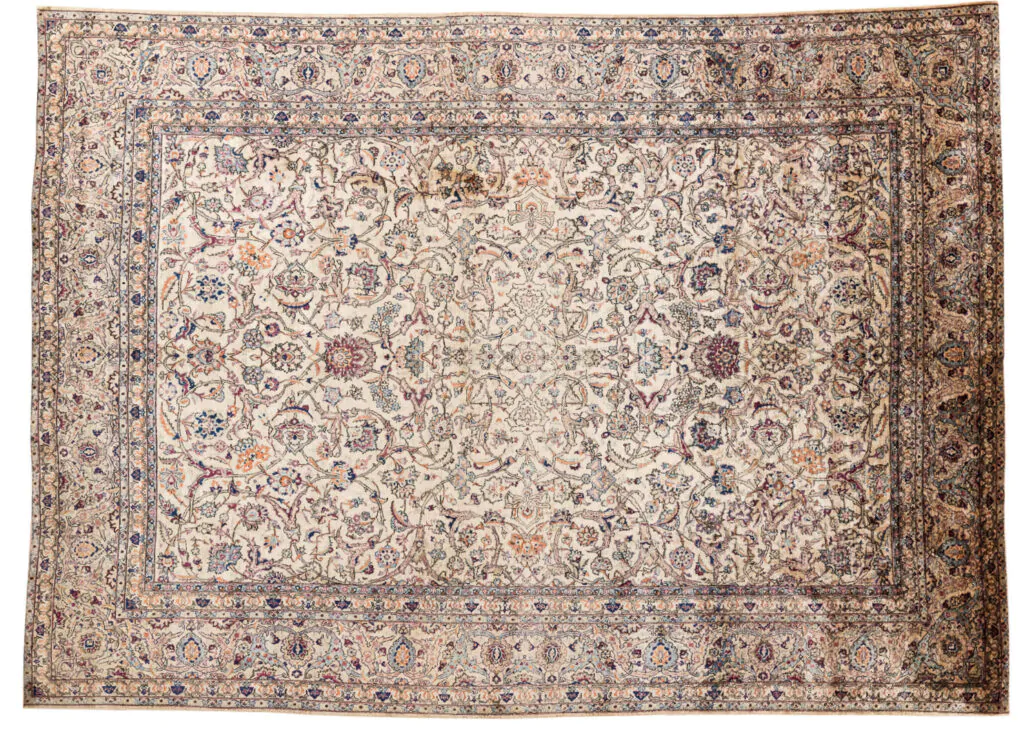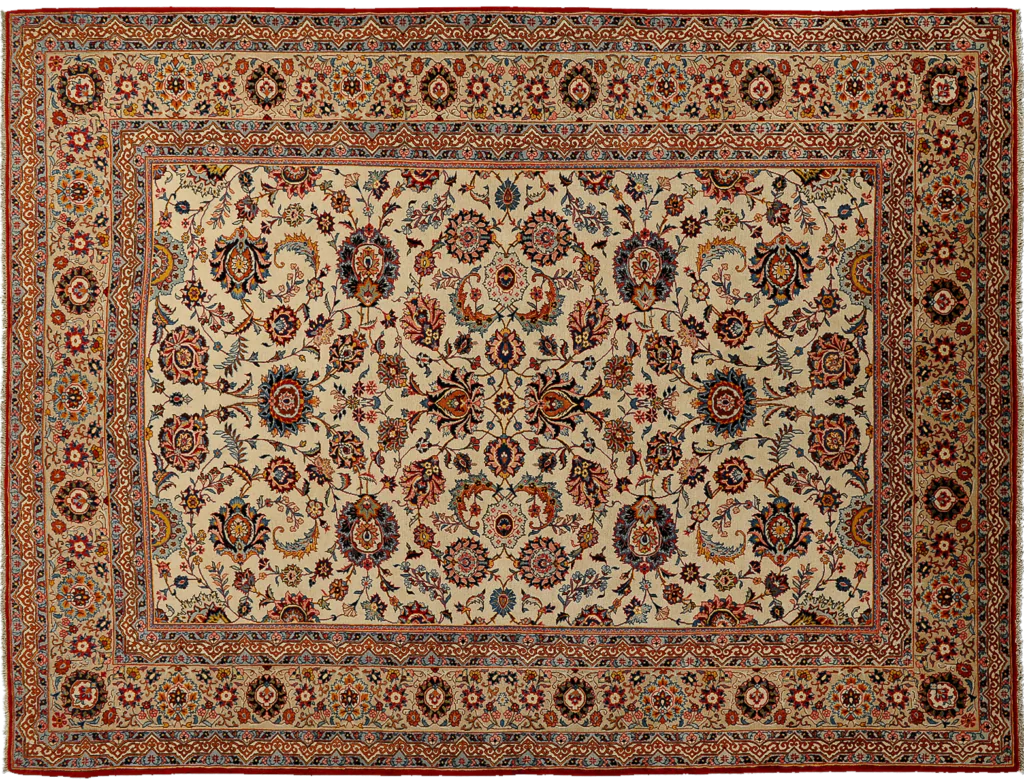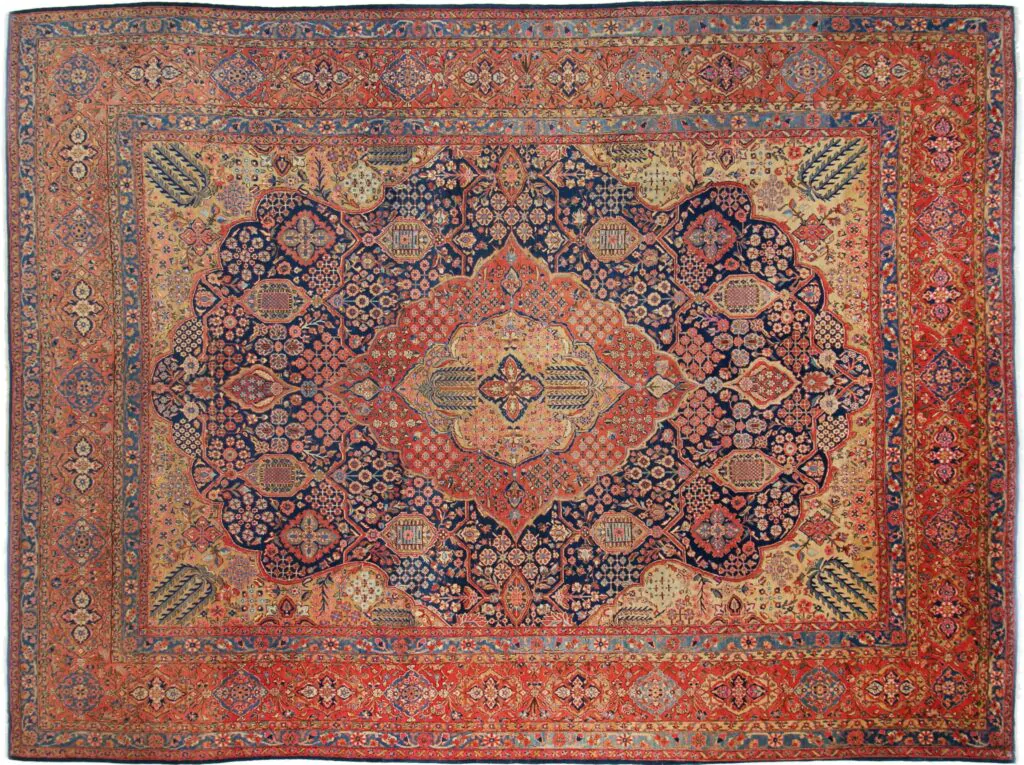Kashan
Kashan, located in the province of Isfahan of Iran, is an oasis on the edge of the Dasht-e Kavir desert. It has always been an important political and artistic center throughout key periods of Persian history and has been considered one of the most important carpet production centers in Persia. Kashan became famous not only for silk-making and textile arts, but also for the production of decorative ceramic tiles. There is evidence that Kashan was one of the first sericulture centers in Persia and some of the finest silk carpets of the Safavid period were probably made there. Even today Kashan continues to play a leading role in the production of Persian silk rugs. Still, since the end of the 19th century, most Kashan rugs have been made from wool which is famous for its softness


Although Kashan rugs are known to have been woven as far back as the Sassanid Empire (224 to 642 AD), there are two main periods of Persian rug production. The first, called the First Golden Age of Persian rugs, took place during the Safavid Empire in the 16th and 17th centuries in court workshops and weaving trade centers. The second, known as the Second Golden Age of Persian rugs, occurred during the late 19th and early 20th centuries under the Qajar rule, when there was a revival in rug production, mainly produced for export but also for the consumption of the Persian elite. In the late 19th century, weavers began producing high-quality rugs, continuing the design and techniques created in the first golden age of Persian rugs.
The Safavid period is known for maximum artistic expression in architecture, manuscript lighting and calligraphy. The rich detailing on domes and walls of mosques, public buildings and private homes, provided an elegant yet pleasurable aesthetic for the interiors, creating a world of gardens and sparkling light sources in sharp contrast to the hostile environment outside. This interior environment created visual pleasure through artistic elements. The Safavid ruler Shah Abbas (1571-1629) established the Bagh-e Fin Gardens in Kashan that still exist today were designated a World Heritage Site by UNESCO. This artistic movement from that period influenced the weaving of carpets.
Kashan carpets from the 16th century made during the Safavid Dynasty are floral in pattern, with very fine detail and high quality, in either a medallion or allover style. Kashan carpets with silk foundation, silk pile as well as cotton foundation and wool pile were made in Shah Abbas design with palmettes, leaves, and vines perfectly set on the background and borders. Other designs such as animals or hunting patterns were displayed in the field. These truly magical weavings are considered important artworks and are displayed in museums worldwide.
In the second half of the 19th century Kashan reemerged as a major center of carpet weaving in Persia. With high demands in Europe and America, master weavers such as Ismail Aba Yahudi, Mohtasham, Tafazoli, and others produced rugs in a variety of sizes. At the turn of the century, Kashan carpet production continued with the master weavers Ateshoghli, Dabir Al Sanayeh, Mohtasham the Younger, and others. During these years, Kashan carpets were made with silk foundation and silk pile or with a cotton foundation and a wool pile.
During the late 19th and the early 20th centuries, Kashan producers traveled to the Kermashan and Khorasan provinces to obtain the best quality wool in Persia. Kashan master weavers also began to purchase Manchester wool made in Australia with merino sheep, that was spun in Manchester, England and dyed in Kashan. These carpets are known as Manchester Kashan and are considered high-quality pieces. They usually feature a very fine detailed allover pattern of vase motifs with flowers, palmettes, leaves, and vines. The main border usually featured large repeating palmettes surrounded by curled leaves and vines. The background was usually rust-red, salmon or maroon-red. Production of the Manchester Kashan was discontinued after 1930’s.
Antique Kashan rugs have a specific design that features an elongated central medallion. Colors tend to be bright, with fields of blue, red and ivory. Other styles include botéh, floral, and vase designs. Borders are often done with stylized floral motifs of palms, tulips, roses, vines and leaves with a central border flanked by two smaller contrasting bands.


The rarest group of Kashan rugs using non-traditional designs and colors is the famous “Mohtasham Kashan” from the late 19th century. Hard to find, this elite Kashan rug uses a lustrous type of lamb’s wool, which gives the rug’s surface a highly luminous quality.
The knots of Mohtasham Kashan rugs are tightly knotted. They feature a graceful medallion shaped like a teardrop or the intricately detailed flower and leaf design. Most prized among collectors are the early Mohtasham Kashan of this style, dating from the mid-19th century and sometimes older. The best of these rugs usually has an ivory or gold backing and are short piled.
The color palette favored by collectors and interior designers is subtle pastels and earth tones, contrasted by a penetrating dark indigo blue. Its colors are vivid and bright and soften significantly over time. At the same time, these tones maintain a remarkable shine, as the rich substance of lanolin takes effect in every fiber of the wool.
Furthermore, early Mohtasham Kashan rugs often feature the abrash technique, which produces the effect of shading and depth by using different shades of the same color. On Mohtasham Kashan rugs dating from the 1850s or earlier, the abrash is usually subtle and continuous, with artistic color shifts within a single design and from one end of the rug to the other. This gives the rug a painterly quality and visual depth similar to that of a watercolor painting. Antique Mohtasham Kashan rugs with extremely well executed restoration and with the pile intact are extremely rare and normally kept in private collections.
The finest 19th and turn of the 20th century Kashan rugs, whether traditional or the elite Mohtasham Kashan are essentially classic and complement any decor. Additionaly, they look great in a variety of other environments, especially large spaces. The finest pieces, if preserved in good or excellent condition and that present an attractive palette of colors, should be considered solid investments in art.


Figalli Oriental Rugs
We do not sell rugs. We bring rare works of art to your home in the form of rugs.
Our services
You are Protected
Copyright © 2023 Figalli Oriental Rugs, All rights reserved. Desenvolvido por Agência DLB – Agência de Marketing Digital em Porto Alegre




